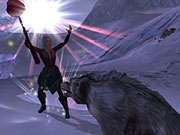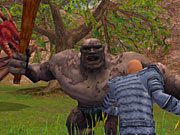Horizons: Empires of Istaria Hands-On Impressions
We jump into the beta test for this upcoming fantasy-themed online role-playing game.
We recently had the opportunity to take a tour of the colorful world of Istaria in Artifact Entertainment's upcoming online game, Horizons. Like other online role-playing games, Horizons lets you create a character, and it lets you go on adventures, fighting monsters and crafting items, like weapons and armor in a huge, persistent world populated by fearsome monsters and lots of like-minded players. But unlike these other games, Horizons has plenty of unusual features, such as dragon player characters, player housing, and player towns, all located in a dynamic world whose geography and geometry can and will change over time. In our recent tour, we visited a few different parts of the world, fought a battle or two, and helped build a house.

Our first stop in the world of Istaria was a small town on the rolling green hills of Spirit Island, the current starting area for new players. Our first order of business was outfitting ourselves with new weapons by crafting them ourselves. Crafting weapons is performed by using a smith's anvil. Your character also needs the proper tools, ingredients, and formulas for forging them. Forging items requires you to equip yourself with a crafting tool (like a forging hammer). Then you click on the formula, in your inventory, to open up a dialog window. You add the necessary ingredients in this window, though you can also add additional modifiers, like components that imbue your weapon with magical properties. Fortunately, if you're not an especially skilled smith, you can also break down existing items to reclaim some of their base resource components, which you can then use to craft more items. Artifact Entertainment plans to start new players with a basic set of tools, and possibly a few basic formulas, but players will need to find, mine, or buy the weapon resources themselves. Higher-level formulas, for producing more-powerful items, will become available to master crafters--who can then teach these formulas to other players. Additionally, certain powerful monsters may also possess the formulas for long-forgotten weapons and armor, and, if slain, they'll leave these formulas behind as loot.
After crafting our weapons, we were ready for battle. Since we were equipped with extremely powerful characters, we were able to easily dispatch our enemies, like Spirit Island's zombies and giant maggots. Engaging in melee combat simply involves targeting enemies, then clicking the "attack" icon in the upper-left corner of the screen to initiate combat. Interestingly, Horizons locks your character's view onto your target while you're in battle so that moving from side to side causes your character to automatically strafe around your target in a circle. While this is an optional feature that can be toggled off, it should help new players keep sight of their targets in battle. However, zombies are the weakest members of the withered aegis--the legion of undead creatures who have begun to invade Istaria. As we saw, their influence extends beyond a few shambling corpses. High-ranking liches, for instance, can corrupt entire areas, turning grassy fields into twisted forests of blackened trees that are shadowed by swirling green nebulas in the sky, effectively blocking out the sun.

We then proceeded to Aughendell, an underground town that belongs to the dwarves. Since Horizons has a fully 3D world, complete with fully defined height and altitudes, the city itself is truly underground and can be traveled to directly from the surface. The architecture in the city reflects the dwarves' love of huge stonework structures. The surface gate to the city is guarded by a huge statue of a somber-looking dwarf, armed with a battleax, while the underground city lies beneath stairways of hewn stone that lead to a stone walkway suspended above a huge chasm. This walkway is divided into different branches on which different skill-training characters await. Horizons has various "schools" of skills that your characters can join, such as a warrior's school, a healer's school, and a crafter's school. Trainer characters teach you basic skills, but you need to improve them yourself through constant practice and adventure.
Our last stop on the tour was a housing area on a southern continent, home to the catlike saris race. Housing plots all have fixed sizes, and players control only one plot per character. However, groups of players who coordinate their building efforts may construct entire towns of private houses, crafting stations (like smithies), and merchant shops (that sell crafted and looted goods). Empty plots of land are indicated by placards, which, when clicked, reveal the plot's current price. Buying a plot lets you add just about anything to it that will fit, including housing structures that require raw materials and craftsmanship to build. Buildings in progress are indicated by bare frameworks surrounded by scaffolding. Clicking on the scaffolding shows how far along the house is and how much, in the way of resources and labor, is required for completion. Interestingly, prospective homeowners can actually include automatic salary rewards for freelance crafters who work on their unfinished homes. If you don't have the time or the inclination to build a home yourself, you can post a notice on your property that invites other crafters to stop by and contribute to its building. They're even automatically paid for their efforts out of your character's own coinpurse.
Horizons: Empires of Istaria seems to offer some extremely interesting ideas that should, hopefully, help distinguish it from its already-intense competition. The game is currently in a beta state and is scheduled for release later this year.
Got a news tip or want to contact us directly? Email news@gamespot.com
Join the conversation